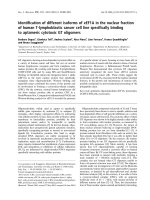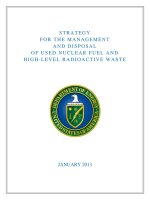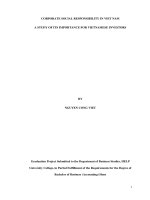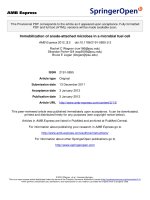Helium solubility in oxide nuclear fuel: Derivation of new correlations for Henry’s constant
Bạn đang xem bản rút gọn của tài liệu. Xem và tải ngay bản đầy đủ của tài liệu tại đây (814.25 KB, 5 trang )
Nuclear Engineering and Design 340 (2018) 240–244
Contents lists available at ScienceDirect
Nuclear Engineering and Design
journal homepage: www.elsevier.com/locate/nucengdes
Helium solubility in oxide nuclear fuel: Derivation of new correlations for Henry’s constant
T
ARTICLE INFO
ABSTRACT
Keywords:
Helium behaviour
Solubility
Henry’s constant
Oxide fuel
Helium plays an important role in determining nuclear fuel performance both in-pile (especially for MOX fuels
and those at high burnup) and in storage conditions. Predictive models of helium behaviour are therefore a
fundamental element in fuel performance codes. These models are based on the accurate knowledge of helium
diffusivity (addressed in a previous paper, Luzzi et al. (2018)) and of helium solubility in oxide nuclear fuel.
Based on all the experimental data available in the literature and after verification of the validity of Henry’s law
we propose two correlations for Henry’s constant, kH (at m 3 MPa 1) :
kH = 1. 8·1025 exp( 0. 41/ kT ) for powders and
kH = 4.1·10 24 exp( 0. 65/ kT ) for single crystals,
with the Boltzmann factor 1/kT in (eV 1). The correlation for Henry’s constant in powder samples is of
interest for the analysis of helium behaviour in the fuel after the pulverization occurring during LOCA-like
temperature transients, while the correlation for Henry’s constant in single-crystals is usable in meso-scale
models describing helium behaviour at the level of fuel grains. The current lack of data for this fundamental
property, especially for poly-crystalline samples, calls for new experiments.
1. Introduction
An accurate knowledge of helium behaviour is fundamental for
evaluating the nuclear fuel performance both in operating and in storage conditions. After production by ternary fissions, (n, )-reactions
and -decay (Botazzoli, 2011; Federici et al., 2007), helium is either
released from the fuel, increasing the fuel rod internal pressure, or retained in the fuel. In the latter case, the behaviour of helium and the
other inert gases produced by fissions (xenon and krypton) within the
matrix of nuclear fuel grains can be considered as a two-step process
(Olander, 1976; Matzke, 1980). The first step is the formation of a
population of intra-granular bubbles, exchanging gas with the matrix
through the trapping and the re-solution mechanisms (absorption into
bubbles and release from the bubbles into the matrix, respectively). The
second process is the diffusion of single gas atoms generated in the fuel
grains towards the grain boundaries. At the grain boundaries, the inflow of the fission gas atoms, which is controlled by the diffusivity and
the solubility, leads to the growth of inter-granular bubbles, whose
interconnection contributes to the fission gas release. The volume occupied by both intra- and inter-granular bubbles contributes to the
gaseous swelling of the fuel (White and Tucker, 1983; Van Uffelen,
2002; Pastore et al., 2018; Barani et al., 2017; Pizzocri et al., 2018).
In general, helium is used as filling gas (typically at a pressure of
20 bars) in the fuel rods of light water reactors (LWRs). During the first
several months of operation, helium initially loaded in the fuel rod free
volume can be absorbed into UO2 (Vinjamuri and Owen, 1980) (this
process depending on the helium pressure, on the fuel temperature and
porosity).
Another complex issue to face is represented by the large quantities
of helium produced in the spent fuel matrix due to -decaying actinides
(Ferry et al., 2006). In fact, the accumulation of helium linked to
-damage creates bubbles at grain-boundaries, which may affect the
spent fuel mechanical properties and could eventually cause loss of
grain cohesion, with the ultimate risk of reducing the spent fuel pellet
to powder (Sattonnay et al., 2006; Wiss et al., 2014; Eyal and Fleischer,
1985; Poinssot et al., 2005). On the other hand, if helium is released
from the spent fuel matrix, it could increase the internal pressure on the
cladding (representing the first confinement barrier) and lead to its
rupture (Freyss et al., 2006).
Therefore, in view of the crucial role played by helium in nuclear fuel,
in the last fifty years several experiments have been performed to investigate its key properties: the diffusivity (Belle, 1961; Rufeh, 1964;
Rufeh et al., 1965; Sung, 1967; Trocellier et al., 2003; Guilbert et al., 2004;
Roudil et al., 2004; Ronchi and Hiernaut, 1967; Martin et al., 2006; Pipon
et al., 2009; Nakajima et al., 2011; Garcia et al., 2012; Talip et al., 2014a;
Luzzi et al., 2018) and the solubility (Belle, 1961; Hasko and Szwarc,
1963; Rufeh, 1964; Rufeh et al., 1965; Sung, 1967; Blanpain et al., 2006;
Maugeri et al., 2009; Nakajima et al., 2011; Talip et al., 2014b).
In this work, we derive new correlations for helium solubility based
on an extensive overview of all the experimental results available in the
open literature. The complementary work on helium diffusivity in oxide
nuclear fuel has been already addressed in a previous paper (Luzzi
et al., 2018). After the verification of the validity of Henry’s law for the
He-UO2 system and the classification of the resulting data on the basis
of the sample microstructure, we derive empirical correlations for
Henry’s constant of helium in uranium dioxide.
2. Methodology
In this work, as first step, we have verified that helium solubility in
UO2 systems can be described by Henry’s law as reported in Section 4. To
this purpose, we have selected a consistent set of experimental data and
verified that the solubility is linearly proportional to the pressure at fixed
temperature. Secondly, the experimental data available in the open
/>Received 23 April 2018; Received in revised form 5 September 2018; Accepted 21 September 2018
Available online 09 October 2018
0029-5493/ © 2018 The Authors. Published by Elsevier B.V. This is an open access article under the CC BY-NC-ND license
( />
Nuclear Engineering and Design 340 (2018) 240–244
Table 1
Comparison of the helium solubility in UO2 powder.
Reference
Sample
Belle (1961)
UO2 powder (≈0.16 μm)
Hasko and Szwarc (1963)
Bostrom (as reported by Rufeh (1964))
Rufeh et al. (1965)
He infusion pressure (MPa)
0.1
UO2 powder
11
UO2 powder (≈0.15 μm)
0.1
1073
4.52·1024
10
UO2 powder (≈10 μm)
6.59·10 22
1.81·10 25
5
8.72·10 24
0.2
1.26·10 23
0.2
1.14·10 23
0.2
Temperature (K)
1073
3.08·10 22
10
3)
2.13 ·1022
9.91·10 22
0.1
UO2 powder (≈4 μm)
Blanpain et al. (2006)
Solubility (at m
1.07·10 23
1073
1273
1473
1473
1573
1273
1473
1573
Table 2
Comparison of the helium solubility in UO2 single crystals.
Reference
Sample
He infusion pressure (MPa)
Hasko and Szwarc (1963)
UO2 single crystal
11
Sung (1967)
UO2 single crystal (≈1 μm)
1.65·10 22
4.8
1.34·10 23
6.9
2.61·10 23
9.0
3.35·10 23
4.8
1.72·10 23
6.9
3.13·10 23
9.0
4.05·1023
4.8
2.02·10 23
6.9
Blanpain et al. (2006)
Maugeri et al. (2009)
Nakajima et al. (2011)
Talip et al. (2014b)
UO2 single crystal (≈10 μm)
UO2 single crystal
UO2 single crystal (≈18 μm)
UO2 single crystal
Solubility (at m
4.05·1023
9.0
5.83·10 23
0.2
1.07·10 22
100
1.38·10 23
100
2.16·10 23
90
1.03·10 25
98.7
1.99·10 23
3)
Temperature (K)
1073
1473
1473
1473
1623
1623
1623
1773
1773
1773
1573
1523
1743
1473
1500
certain infusion time at a fixed helium pressure and temperature. If the
infusion time is enough, equilibrium is reached, and the infused helium
concentration corresponds to the solubility. Tables 1 and 2 report all
the experimental results available in literature.
Helium solubility in uranium dioxide has been also studied theoretically by Olander (1965), Yakub et al. (2010), Yakub (2011), and
more recently by Noirot (2014). Olander (1965) derived the helium
solubility in UO2 directly from atomic properties, basing the calculations upon a statistical-mechanical formula which assumes dissolved
helium to behave as a simple harmonic oscillator in an interstitial site in
the UO2 lattice. Furthermore, Yakub et al. (2010) and Yakub (2011)
performed molecular dynamics (MD) simulations determining the helium solubility in UO2 as a function of temperature and UO2 stoichiometry. Two-box MD simulations were performed in a wide range of
helium pressures from those achieved in infusion experiments (a few
MPa) up to 4 GPa, as reported in Yakub (2011). The comparison of the
simulation results for stoichiometric UO2 with existing measurements
shows a good agreement with the experimental data of helium solubility in single crystals and a maximum discrepancy of ± 1% with the
correlation for Henry’s constant in single crystal proposed in this work.
In addition, no essential deviations from the linear dependence of solubility on pressure was found up to around 0.5 GPa. Recently, Noirot
(2014) derived the theoretical value for Henry’s constant applying to
helium in interstitial positions in UO2 a method devised to calculate the
equilibrium concentration of point defects and gas atoms in the vicinity
of a bubble in UO2. Noirot performed the calculations for different incorporation energies of an helium atom in an interstitial position and
for different activation energies for the diffusion of helium in UO2,
obtaining consistent results with both the molecular dynamics computation and the experimental data, and with a maximum discrepancy
literature have been classified on the basis of the microstructure of the
measured samples, obtaining two new correlations with limited application scope (as explained in Section 4). In principle, classifications based on
different parameters, such as the O/M ratio, the initial porosity and the
density of the samples, can also be made. However, not all the studies in
literature report the necessary data, making a more elaborate analysis not
trivial. In general, in literature several experimental (Belle, 1961; Hasko
and Szwarc, 1963; Rufeh, 1964; Rufeh et al., 1965; Sung, 1967; Blanpain
et al., 2006; Maugeri et al., 2009; Nakajima et al., 2011; Talip et al.,
2014b) and theoretical studies concerning the behaviour of helium in
nuclear fuel are available (Olander, 1965; Grimes et al., 1990;
Crocombette, 2002; Petit et al., 2003; Garrido et al., 2004; Freyss et al.,
2006; Parfitt and Grimes, 2008; Yun et al., 2009; Gryaznov et al., 2010;
Yakub et al., 2010; Yakub, 2011; Noirot, 2014). Unfortunately, only few
theoretical analyses (Olander, 1965; Yakub et al., 2010; Yakub, 2011;
Noirot, 2014) provide a solubility value that is even calculated with very
different approaches. For this reason, we have decided to derive the correlations to be implemented in physics-based models only on the basis of
experimental data. To minimize the influence of outliers, we have fitted
the available experimental data using a robust regression method, namely
the least absolute residuals (LAR) procedure (Heiser, 1987). The LAR
method finds a curve that minimizes the absolute difference of the residuals, rather than the squared differences. Therefore, extreme values
have a lesser influence on the fit.
3. Overview of available data
All the measurements of helium solubility have been performed by
infusion and, as discussed in Section 2, have been classified only on the
basis of the microstructure. The sample to be infused is kept for a
241
Nuclear Engineering and Design 340 (2018) 240–244
Fig. 1. Comparison of theoretical plot of Henry’s law Cs = kH p with experimental results for He-UO2 system. In detail, the dots are the experimental values for the
helium solubility in UO2 obtained by Sung (1967), while each line represents the linear regression calculated for the data measured at the same temperature.
Fig. 2. Plot of the experimental Henry’s constant of helium in UO2 classified depending on the microstructure of the sample (i.e., blue for the powder samples and red
for the single crystal samples). Each cluster is fitted by a distinct correlation (bordeaux and blue navy).
of ± 1% with our correlation for single crystals (shown in Section 4).
distinct correlations in the form kH = A exp[ B / kT ]. The best estimate
correlation for Henry’s constant in the powder samples is:
4. Results and discussion
kH = 1.8·1025 exp
As shown in Fig. 1, it has been verified that solubility is proportional
to infusion pressure and the system He-UO2 obeys Henry’s law (Fig. 1)
(Rufeh, 1964; Rufeh et al., 1965; Sung, 1967; Maugeri et al., 2009;
Nakajima et al., 2011):
Cs = kH p
0. 41
kT
(2)
where kH (at m 3 MPa 1) is Henry’s constant, k (eV K 1) the Boltzmann
constant and T (K) is the temperature. On the other hand, the best estimate correlation for Henry’s constant in the single crystal samples is:
(1)
kH = 4.1·1024 exp
where Cs (at m 3 ) is the solubility, kH (at m 3 MPa 1) is Henry’s constant
and p (MPa) is the infusion pressure.
The collected experimental results appear divided in two clusters of
data, corresponding to the categorization based on the sample microstructure (Fig. 2). In detail, the cluster in the upper region of the plot
includes the powder samples, while the other one in the lower region of
the plot includes the single crystal samples.
Despite the large scatter of the experimental results for the helium
solubility in uranium dioxide, the resulting clustering of the data (not
further critically evaluated here) motivated the derivation of two
0. 65
kT
(3)
Table 3 reports the fitting parameters with the related uncertainties1
We calculated the uncertainty on the prediction of the solubility by
propagating the uncertainty of each fitting parameter. The resulting
uncertainty is of the order of a factor of one thousand (×1000) for each
correlation herein proposed, while the uncertainty of the fit made
1
These fitting parameters have been derived applying the LAR (Least
Absolute Residuals) method.
242
Nuclear Engineering and Design 340 (2018) 240–244
Table 3
Summary of the information concerning the fit of correlations. The form is LogkH = LogA − B/ kT Loge. For each fitting parameter, we report in round brackets the
confidence intervals at 95% confidence level.
Data
LogA (at m
Powder (Belle, 1961; Hasko and Szwarc, 1963; Rufeh, 1964; Rufeh et al., 1965; Blanpain et al., 2006)
Single crystal (Hasko and Szwarc, 1963; Sung, 1967; Blanpain et al., 2006; Maugeri et al., 2009; Nakajima et al.,
2011; Talip et al., 2014b)
25.25 (23.91, 26.6)
24.61 (23.41, 25.82)
considering all the data is a factor of ten thousands (×10,000). The
proposed categorization therefore allows for a reduction of uncertainties of a factor of ten.
Regarding the applicability, the correlation derived fitting the data
concerning the powder samples is usable for the analysis of the helium
behaviour in the fuel after the pulverization occurring during LOCA-like
temperature transients (Bianco et al., 2015; Cappia, 2017). On the other
hand, the correlation proposed for Henry’s constant in single crystals is
of interest for calculations in meso-scale models dealing with fuel at
grain level (like models used in the fuel performance codes for the
description of fission gases referring to the fuel grain scale).
Fig. 2 reports all the experimental results analyzed in this work,
together with the herein derived correlations for Henry’s constant of
helium in UO2. The overall range of temperature covered by the
available data is 1073–1773 K.
3
MPa
1)
B (eV)
Range (K)
R2
0.41 (0.06, 0.75)
0.65 (0.28, 1.01)
1073–1773
1073–1773
0.83
0.83
Blanpain, P., Lippens, M., Schut, H., Federov, A.V., Bakker, K., 2006. Helium solubility in
UO2 , The HARLEM project. Workshop MMSNF-5, Nice, France.
Botazzoli, P., 2011. Helium production and behaviour in LWR oxide nuclear fuels (Ph.D.
thesis). Politecnico di Milano 4–39.
Cappia, F., 2017. Investigation of very high burnup UO2 fuels in Light Water Reactors
(Ph.D. thesis). Technische Universitat Munchen 47–61.
Crocombette, J.-P., 2002. Ab initio energetics of some fission products (Kr, I, Cs, Sr and
He) in uranium dioxide. J. Nucl. Mater. 305, 29–36.
Eyal, Y., Fleischer, R.L., 1985. Timescale of natural annealing in radioactive minerals
affects retardation of radiation-damage-induced leaching. Nature 314, 518–520.
Federici, E., Courcelle, A., Blanpain, P., Cognon, H., 2007. Helium production and behavior in nuclear oxide fuels during irradiation in LWR. In: Proceedings of the 2007
International LWR Fuel Perfomance Meeting, San Francisco, California. pp. 664–673.
Ferry, C., Poinssot, C., Cappelaere, C., Desgranges, L., Jegou, C., Miserque, F., Piron, J.P.,
Roudil, D., Gras, J.M., 2006. Specific outcomes of the research on the spent fuel longterm evolution in interim dry storage and deep geological disposal. J. Nucl. Mater.
352, 246–253.
Freyss, M., Vergnet, N., Petit, T., 2006. Ab initio modeling of the behavior of helium and
xenon in actinide dioxide nuclear fuels. J. Nucl. Mater. 352, 144–150.
Garcia, P., Martin, G., Desgardin, P., Carlot, G., Sauvage, T., Sabathier, C., Castellier, H.,
Khodja, H., Barthe, M.F., 2012. A study of helium mobility in polycrystalline uranium
dioxide. J. Nucl. Mater. 430, 156–165.
Garrido, F., Nowicki, L., Sattonnay, G., Sauvage, T., Thom, L., 2004. Lattice location of
helium in uranium dioxide single crystals. Nucl. Instr. Meth. Phys. Res. Sect. B
219–220, 194–199.
Grimes, R.W., Miller, R.H., Catlow, C.R.A., 1990. The behavior of helium in UO2 : Solution
and migration energies. J. Nucl. Mater. 172, 123–125.
Gryaznov, D., Rashkeev, S., Kotomin, E.A., Heifets, E., Zhukovskii, Y., 2010. Helium
behavior in oxide nuclear fuels: First principles modeling. Nucl. Instr. Meth. Phys.
Res. B 268, 3090–3094.
Guilbert, S., Sauvage, T., Garcia, P., Carlot, G., Barthe, M.F., Desgardin, P., Blondiaux, G.,
Corbel, C., Piron, J.P., Gras, J.M., 2004. He migration in implanted UO2 sintered
disks. J. Nucl. Mater. 327, 88–96.
Hasko, S., Szwarc, R., 1963. Noble gas solubility and diffusion in UO2 . AEC Division of
Reactor Development. Washington.
Heiser, W.J., 1987. Correspondence analysis with least absolute residuals. Comput. Stat.
Data Anal. 5, 337–356.
Luzzi, L., Cognini, L., Pizzocri, D., Barani, T., Pastore, G., Schubert, A., Wiss, T., Van
Uffelen, P., 2018. Helium diffusivity in oxide nuclear fuel: Critical data analysis and
new correlations. Nuclear Eng. Des. 330, 265–271.
Martin, G., Garcia, P., Labrim, H., Sauvage, T., Carlot, G., Desgardin, P., Barthe, M.F.,
Piron, J.P., 2006. A NRA study of temperature and heavy ion irradiation effects on
helium migration in sintered uranium dioxide. J. Nucl. Mater. 357, 198–205.
Matzke, H., 1980. Gas release mechanisms in UO2 – a critical review. Radiat. Effects 53,
219–242.
Maugeri, E.A., Wiss, T., Hiernaut, J.P., Desai, K., Thiriet, C., Rondinella, V.V., Colle, J.Y.,
Konings, R.J.M., 2009. Helium solubility and behaviour in uranium dioxide. J. Nucl.
Mater. 385, 461–466.
Nakajima, K., Serizawa, H., Shirasu, N., Haga, Y., Arai, Y., 2011. The solubility and diffusion coefficient of helium in uranium dioxide. J. Nucl. Mater. 419, 272–280.
Noirot, L., 2014. A method to calculate equilibrium concentrations of gas and defects in
the vicinity of an over-pressured bubble in UO2 . J. Nucl. Mater. 447, 166–178.
Olander, D.R., 1965. Theory of helium dissolution in uranium dioxide. II. Helium solubility. J. Chem. Phys. 43, 785–788.
Olander, D.R., 1976. Fundamental aspects of nuclear reactor fuel elements.
Parfitt, D.C., Grimes, R.W., 2008. Predicted mechanisms for radiation enhanced helium
resolution in uranium dioxide. J. Nucl. Mater. 381, 216–222.
Pastore, G., Barani, T., Pizzocri, D., Magni, A., Luzzi, L., 2018. Modelling fission gas release and bubble evolution in UO2 for engineering fuel rod analysis, accepted contribution for TopFuel2018, Prague, 30.09-04.10.2018.
Petit, T., Freyss, M., Garcia, P., Martin, P., Ripert, M., Crocombette, J.-P., Jollet, F., 2003.
Molecular modelling of transmutation fuels and targets. J. Nucl. Mater. 320,
133–137.
Pipon, Y., Raepsaet, C., Roudil, D., Khodja, H., 2009. The use of NRA to study thermal
diffusion of helium in (U, Pu)O2. J. Nucl. Mater. 267, 2250–2254.
Pizzocri, D., Pastore, G., Luzzi, L., Barani, T., Magni, A., Van Uffelen, P., Pitts, S.A.,
Alfonsi, A., Hales, J.D., 2018. A model describing intra-granular inert gas behavior in
oxide fuel for advanced engineering tools. J. Nucl. Mater. 502, 323–330.
Poinssot, C., Ferry, C., Lovera, P., Jegou, C., Gras, J.-M., 2005. Spent fuel radionuclide
source term model for assessing spent fuel performance in geological disposal. Part II:
matrix alteration model and global performance. J. Nucl. Mater. 346, 66–77.
Ronchi, C., Hiernaut, J.P., 1967. Helium diffusion in uranium and plutonium oxides. J.
Nucl. Mater. 325, 1–12.
Roudil, D., Deschanels, X., Trocellier, P., Jégou, C., Peuget, S., Bart, J.M., 2004. Helium
5. Conclusions
We made an overview of all the experimental results for the helium
solubility in UO2 available in literature. Two clusters emerged based on
the microstructure of the measured samples, i.e., powders vs. single
crystals. The clustering of the experimental results motivated the derivation of two distinct correlations for Henry’s constant as a function of
temperature. Recommendations are provided for each new proposed
correlation in terms of applicability. This allows obtaining a powder
solubility value suitable for describing the helium behaviour in the fuel
after his pulverization, and a single crystal solubility value suitable for
describing the helium behaviour inside a grain (i.e., for meso-scale
models). New experiments would be of great interest, to reduce the
uncertainty associated with these correlations and to fill the lack of data
concerning the helium solubility in polycrystalline samples with further
varying temperatures, oxygen potential and irradiation damage levels.
It would be of interest investigating the solubility of helium at higher as
well as lower temperatures (for the simulation of nuclear fuel in storage
conditions) as more experimental data will become available. Indeed, it
would also be interesting to derive a correlation for polycrystalline
samples in order to describe the helium behaviour on a macroscopic
scale (e.g., in a UO2 pellet).
Acknowledgments
This work has received funding from the Euratom research and
training programme 2014–2018 through the INSPYRE Project under
grant agreement No 754329. This research contributes to the Joint
Programme on Nuclear Materials (JPNM) of the European Energy
Research Alliance (EERA), in the specific framework of the
COMBATFUEL Project.
References
Barani, T., Bruschi, E., Pizzocri, D., Pastore, G., Van Uffelen, P., Williamson, R.L., Luzzi,
L., 2017. Analysis of transient fission gas behaviour in oxide fuel using BISON and
TRANSURANUS. J. Nucl. Mater. 486, 96–110.
Belle, J., 1961. Uranium dioxide: properties and nuclear applications. United States Atom.
Energy Commission 569–589.
Bianco, A., Vitanza, C., Seidl, M., Wensauer, A., Faber, W., Macian-Juan, R., 2015.
Experimental investigation on the causes for the pellet fragmentation. J. Nucl. Mater.
465, 260–267.
243
Nuclear Engineering and Design 340 (2018) 240–244
thermal diffusion in a uranium dioxide matrix. J. Nucl. Mater. 325, 148–158.
Rufeh, F., 1964. Solubility of helium in uranium dioxide (M.Sc. thesis). University of
California 13–26.
Rufeh, F., Olander, D.R., Pigford, T.H., 1965. The solubility of helium in uranium dioxide.
Nucl. Sci. Eng. 23, 335–338.
Sattonnay, G., Vincent, L., Garrido, F., Thom, L., 2006. Xenon versus helium behavior in
UO2 single crystals: a TEM investigation. J. Nucl. Mater. 355, 131–135.
Sung, P., 1967. Equilibrium solubility and diffusivity in single-crystal uranium dioxide
(Ph.D. thesis). University of Washington 23–29.
Talip, Z., Wiss, T., Di Marcello, V., Janssen, A., Colle, J.Y., Van Uffelen, P., Raison, P.E.,
Konings, R.J.M., 2014a. Thermal diffusion of helium in 238Pu-doped UO2 . J. Nucl.
Mater. 445, 117–127.
Talip, Z., Wiss, T., Maugeri, E.A., Colle, J.Y., Raison, P.E., Gilabert, E., Ernstberger, M.,
Staicu, D., Konings, R.J.M., 2014b. Helium behaviour in stoichiometric and hyperstoichiometric UO2 . J. Eur. Ceram. Soc. 34, 1265–1277.
Trocellier, P., Gosset, D., Simeone, D., Costantini, J.M., Deschanels, X., Roudil, D.,
Serruys, Y., Grynszpan, R., Saud, S., Beauvy, M., 2003. Application of nuclear reaction geometry for 3He depth profiling in nuclear ceramics. Nucl. Instr. Methods Phys.
Res. B 206, 1077–1082.
Van Uffelen, P., 2002. Contribution to the modelling of fission gas release in light water
reactor fuel (Ph.D. thesis). Universit de Liege and SCK-CEN 5–34.
Vinjamuri, K., Owen, D.E., 1980. Helium fill gas absorption in pressurized UO2 fuel rods
during irradiation. Nucl. Technol. 47, 119–124.
⁎
White, R.J., Tucker, M.O., 1983. A new fission-gas release model. J. Nucl. Mater. 118,
1–38.
Wiss, T., Hiernaut, J.P., Roudil, D., Colle, J.Y., Maugeri, E., Talip, Z., Janssen, A.,
Rondinella, V.V., Konings, R.J.M., Matzke, H.J., Weber, W.J., 2014. Evolution of
spent nuclear fuel in dry storage conditions for millennia and beyond. J. Nucl. Mater.
451, 198–206.
Yakub, E., 2011. Helium solubility in uranium dioxide from molecular dynamics simulations. J. Nucl. Mater. 414, 83–87.
Yakub, E., Ronchi, C., Staicu, D., 2010. Diffusion of helium in non-stoichiometric uranium
dioxide. J. Nucl. Mater. 400, 189–195.
Yun, Y., Eriksson, O., Oppeneer, P.M., Kim, H., Park, K., 2009. First-principles theory for
helium and xenon diffusion in uranium dioxide. J. Nucl. Mater. 385, 364–367.
L. Cogninia, D. Pizzocria, T. Barania, P. Van Uffelenb, A. Schubertb,
⁎
T. Wissb, L. Luzzia,
a
Politecnico di Milano, Department of Energy, Nuclear Engineering
Division, via La Masa 34, I-20156 Milano, Italy
b
European Commission, Joint Research Centre, Directorate for Nuclear
Safety and Security, P.O. Box 2340, 76125 Karlsruhe, Germany
E-mail address: (L. Luzzi)
Corresponding author.
244









